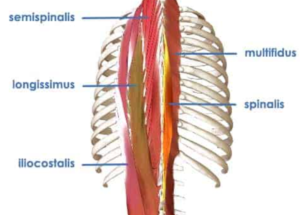THE MULTIFIDUS

…. is a deep muscle that sits close to the spine and runs vertically in small segments of approximately 2-3 vertebrae from the back of the pelvis to the base of the skull. It provides segmental stability of individual joints and protects the spine in rotational activities. Because of its location being deeper and closer to the spine than other back muscles, it should engage first to control the spine then the more superficial muscles activate to assist with global movement.
One of the most astounding characteristics of this muscle is the fact that it anticipates movement. There are 4 muscle groups that co-activate together in the very same manner: the pelvic floor, the diaphragm, the transverse abdominus and the multifidus. These muscles provide the stability required for optimal mobility to build upon. Those who try to activate the front abdominal wall only have a great amount of difficulty controlling their spine. They instead flex or extend their back in inappropriate ways. If their ribs and pelvis are not stacked properly, their breathing mechanics become greatly ineffective. Activating the multifidus can help maintain optimal spinal support.
As you exhale, imagine the back of the pelvis closing like elevator doors and lifting up towards the base of the skull, dragging more height of the spine as the elevator rises. Sometimes you will discover a portion of the area around the spine that doesn’t feel as activated. If you make slight adjustments of your torso, it may help put the muscle in optimal position to engage. Or try to elongate your exhalation.
The bigger, more superficial muscles that can over-engage are the Erector Spinae or the Iliocostalis. When these muscles work too hard, they can cause timing and activation problems of the multifidus. They are the bigger, meatier muscles of the back that have superficial fibers. These feel different when engaged than the multifidus. When the multifidus is activated, you should also feel the front of your body strengthen and lift – that is the coactivation of the transversus, pelvic floor, and diaphragm.
NOTE: The multifidus muscle group is represented in studies with conflicting evidence about whether it is possible to cue it or not for successful activation. I acknowledge the literature because they do point out important facts that continue to change as we learn more. What I also want for you to appreciate is that some people can respond to cues or have different muscle control than others. This can affect the studies, but it also means teachers must come armed with a collection of perspectives for the variety of bodies in class. Have fun and explore what works best for you!
Here are some videos I hope will help you find a deeper sense of your core stabilization.
Classes with Justina: https://youtu.be/hcFYNAAcBlE
Dooley Noted: https://www.youtube.com/watch?v=8AjsnwJZhlY
Where Lumbar Stability Begins: https://www.youtube.com/watch?v=tNhC9BYgKMc
We explore new ways to engage and strengthen the multifidus muscle in some classes with Justina.
